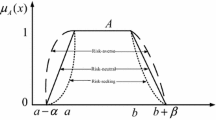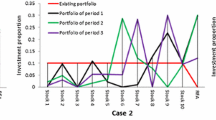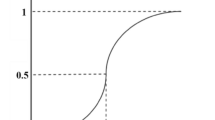Abstract
The aim of this paper is to investigate the effects of higher moments on multi-period portfolio selection with fuzzy returns. This paper gives the definitions of possibilistic mean and variance about the product of multiple fuzzy numbers. Based on these definitions, three multi-period fuzzy portfolio optimization models are proposed. The proposed models aim to maximize terminal wealth and minimize terminal risk by taking into account some realistic constraints including higher moments, budget constraint, round-lot constraint, cardinality constraint and bound constraint. To ensure the selection of the best solutions, a novel fuzzy programming approach-based self-adaptive differential evolution algorithm is designed to solve the proposed models. A numerical example is given to demonstrate the application of the proposed models. Computational results show that the designed algorithm is effective for solving complex portfolio selection model with realistic constraints.
Similar content being viewed by others
References
Ammar, E., & Khalifa, H. A. (2003). Fuzzy portfolio optimization: A quadratic programming approach. Chaos, Solitons & Fractals, 18(5), 1045–1054.
Ballestero, E., Günther, M., Pla-Santamaria, D., & Stummer, C. (2007). Portfolio selection under strict uncertainty: A multi-criteria methodology and its application to the Frankfurt and Vienna stock exchanges. European Journal of Operational Research, 181(3), 1476–1487.
Bellman, R., & Zadeh, L. A. (1970). Decision making in a fuzzy environment. Management Science, 17(4), 141–164.
Briec, W., Kerstens, K., & Jokung, O. (2007). Mean–variance–skewness portfolio performance gauging: A general shortage function and dual approach. Management Science, 53(1), 135–149.
Carli, R., Dotoli, M., Pellegrino, R., & Ranieri, L. (2017). A decision making technique to optimize a buildings’ stock energy efficiency. IEEE Transactions on Systems, Man, and Cybernetics: Systems, 47(5), 794–807.
Carlsson, C., & Fullér, R. (2001). On possibilistic mean value and variance of fuzzy numbers. Fuzzy Sets and Systems, 122(2), 315–326.
Chen, W. (2015). Artificial bee colony algorithm for constrained possibilistic portfolio optimization problem. Physica A, 429, 125–139.
Chen, W., & Tan, S. (2009). On the possibilistic mean value and variance of multiplication of fuzzy numbers. Journal of Computational and Applied Mathematics, 232(2), 327–334.
Cheng, C. B. (2004). Group opinion aggregation based on a grading process: A method for constructing triangular fuzzy numbers. Computers & Mathematics with Applications, 48(10–11), 1619–1632.
Devi, B. B., & Sarma, V. V. S. (1985). Estimation of fuzzy memberships from histograms. Information Sciences, 35(1), 43–59.
Díaz, A., González, M. D. L. O., Navarro, E., & Skinner, F. S. (2009). An evaluation of contingent immunization. Journal of Banking & Finance, 33(10), 1874–1883.
DiTraglia, F. J., & Gerlach, J. R. (2013). Portfolio selection: An extreme value approach. Journal of Banking & Finance, 37(2), 305–323.
Dubios, D., & Prade, H. (1980). Fuzzy sets and system: Theory and application. New York: Academic Press.
Fang, H., & Lai, T. Y. (1997). Go-kurtosis and capital asset pricing. Financial Review, 32(2), 293–307.
Ge, B., Hipel, K. W., Fang, L., Yang, K., & Chen, Y. (2014). An interactive portfolio decision analysis approach for system-of-systems architecting using the graph model for conflict resolution. IEEE Transactions on Systems, Man, and Cybernetics: Systems, 44(10), 1328–1346.
Gong, C., Xu, C., Wang, J. (2017). An efficient adaptive real coded genetic algorithm to solve the portfolio choice problem under cumulative prospect theory. Computational Economics, 1C26 (in press).
Ghosh, A., Das, S., Chowdhury, A., & Giri, R. (2011). An improved differential evolution algorithm with fitness-based adaptation of the control parameters. Information Sciences, 181(18), 3749–3765.
Guo, S., Yu, L., Li, X., & Kar, S. (2016). Fuzzy multi-period portfolio selection with different investment horizons. European Journal of Operational Research, 254(3), 1026–1035.
Gupta, P., Mehlawat, M. K., & Saxena, A. (2008). Asset portfolio optimization using fuzzy mathematical programming. Information Sciences, 178(6), 1734–1755.
Hjalmarsson, E., & Manchev, P. (2012). Characteristic-based mean–variance portfolio choice. Journal of Banking & Finance, 36(5), 1392–1401.
Jalota, H., Thakur, M., & Mittal, G. (2017). Modelling and constructing membership function for uncertain portfolio parameters: A credibilistic framework. Expert Systems with Applications, 71, 40–56.
Kim, T. (2015). Does individual-stock skewness/coskewness reflect portfolio risk? Finance Research Letters, 15, 167–174.
Kumar, R., & Bhattacharya, S. (2012). Cooperative search using agents for cardinality constrained portfolio selection problem. IEEE Transactions on Systems, Man, and Cybernetics, Part C, 42(6), 1510–1518.
Leung, M. T., Daouk, H., & Chen, A. S. (2001). Using investment portfolio returns to combine forecasts: A multi-objective approach. European Journal of Operational Research, 134(1), 84–102.
Li, X., Guo, S., & Yu, L. (2015). Skewness of Fuzzy Numbers and Its Applications in Portfolio Selection. IEEE Transactions on Fuzzy Systems, 23(6), 2135–2143.
Li, J., Liu, G., Yan, C., & Jiang, C. (2017). Robust learning to rank based on portfolio theory and AMOSA algorithm. IEEE Transactions on Systems, Man, and Cybernetics: Systems, 77(6), 1007–1018.
Li, X., Qin, Z. F., & Kar, S. (2010). Mean–variance–skewness model for portfolio selection with fuzzy returns. European Journal of Operational Research, 202(1), 239–247.
Liu, L., Shenoy, C., & Shenoy, P. P. (2006). Knowledge representation and integration for portfolio evaluation using linear belief functions. IEEE Transactions on Systems, Man, and Cybernetics-Part A: Systems and Humans, 36(4), 774–785.
Liu, Y. J., & Zhang, W. G. (2013). Fuzzy portfolio optimization model under real constraints. Insurance: Mathematics and Economics, 53(3), 704–711.
Mashayekhi, Z., & Omrani, H. (2016). An integrated multi-objective Markowitz-DEA cross-efficiency model with fuzzy returns for portfolio selection problem. Applied Soft Computing, 38, 1–9.
Mehlawat, M. K. (2016). Credibilistic mean-entropy models for multi-period portfolio selection with multi-choice aspiration levels. Information Sciences, 345, 9–26.
Mohamed, A. W., & Sabry, H. Z. (2012). Constrained optimization based on modified differential evolution algorithm. Information Sciences, 194, 171–208.
Saborido, R., Ruiz, A. B., Bermúdez, J. D., Vercher, E., & Luque, M. (2016). Evolutionary multi-objective optimization algorithms for fuzzy portfolio selection. Applied Soft Computing, 39, 48–63.
Saeidifar, A., & Pasha, E. (2009). The possibilistic moments of fuzzy numbers and their applications. Journal of Computational and Applied Mathematics, 223(2), 1028–1042.
Shen, Y. (2015). Mean–variance portfolio selection in a complete market with unbounded random coefficients. Automatica, 55, 165–175.
Storn, R., & Price, K. (1995). Differential evolution—a simple and efficient adaptive scheme for global optimization over continuous spaces, Technical Report TR-95-012. International Computer Science Institute, Berkeley, CA.
Utz, S., Wimmer, M., Hirschberger, M., & Steuer, R. E. (2014). Tri-criterion inverse portfolio optimization with application to socially responsible mutual funds. European Journal of Operational Research, 234(2), 491–498.
Wu, L. H., & Wang, Y. N. (2007). Self-adapting control parameters modified differential evolution for trajectory planning manipulator. Control Theory and Technology, 5(4), 365–373.
Yu, J. R., & Lee, W. Y. (2011). Portfolio rebalancing model using multiple criteria. European Journal of Operational Research, 209(2), 166–175.
Zadeh, L. A. (1965). Fuzzy sets. Information and Control, 8(3), 338–353.
Zhang, W. G., Liu, Y. J., & Xu, W. J. (2012). A possibilistic mean-semivariance-entropy model for multi-period portfolio selection with transaction costs. European Journal of Operational Research, 222(2), 341–349.
Zhang, W. G., Xiao, W. L., & Xu, W. J. (2010a). A possibilistic portfolio adjusting model with new added assets. Economic Modelling, 27(1), 208–213.
Zhang, X. L., Zhang, W. G., Xu, W. J., & Xiao, W. L. (2010b). Possibilistic approaches to portfolio selection problem with general transaction costs and a CLPSO algorithm. Computational Economics, 36(3), 191–200.
Zimmermann, H. J. (1978). Fuzzy programming and linear programming with several objective functions. Fuzzy Sets and Systems, 1(1), 45–55.
Acknowledgements
This research was supported by the National Natural Science Foundation of China (Nos. 71501076 and 71720107002), the Natural Science Foundation of Guangdong Province of China (No. 2017A030312001), the Fundamental Research Funds for the Central Universities (No. 2017ZD102) and Guangzhou Financial Services Innovation and Risk Management Research Base.
Author information
Authors and Affiliations
Corresponding author
Appendix
Appendix
Proof
(i) By Definition 1, we have \(M^{-}(A_{i})={\int }_{0}^{1}\gamma \underline{a}_{i}(\gamma )\text {d}\gamma \), \(M^{+}(A_{i})={\int }_{0}^{1}\gamma \overline{a}_{i}(\gamma )\text {d}\gamma \) and \(E(A_{i})=\tfrac{1}{2}(M^{-}(A_{i})+M^{+}(A_{i}))\). Then, by Eq. (7), we have
(ii) According to Eq. (8), we have
Notice that the rth item in Eq. (36) can be represented by
It follows that Eq. (37) can be rewritten as the following form
Notice that \(\tfrac{1}{2^{n-1}}\prod \limits _{i = 1}^n E(A_{i})[\prod \limits _{i = 1}^n M^{-}(A_{i})+\sum \limits _{r = 1}^{n-2}\mathop {\mathop {\mathop {\sum }\limits _{k_{j}=1}}\limits _{\;j\in \{1,2,\ldots ,r\}}}^{n}\prod \limits _{j = 1}^r M^{+}(A_{k_{j}}) \mathop {\mathop {\mathop {\prod }\limits _{ i = 1}} \limits _{ i \ne k_{j}}}^n M^{-}(A_{i})+\prod \limits _{i = 1}^n M^{+}(A_{i})]=2(\prod \limits _{i = 1}^n E(A_{i}))^{2}\). Then, we have
The theorem is proved. \(\square \)
Rights and permissions
About this article
Cite this article
Liu, YJ., Zhang, WG. Possibilistic Moment Models for Multi-period Portfolio Selection with Fuzzy Returns. Comput Econ 53, 1657–1686 (2019). https://doi.org/10.1007/s10614-018-9833-6
Accepted:
Published:
Issue Date:
DOI: https://doi.org/10.1007/s10614-018-9833-6




